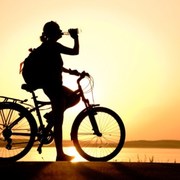 Hemera/Thinkstock
Hemera/Thinkstock
Long, warm sunny days are what we dream about as winter turns to spring and spring finally gives way to summer.
We welcome the sun, and look forward to spending time outside.
At first.
But when the temperatures sky-rocket, the sun no longer seems so friendly.
Heat stroke is a form of hyperthermia that, if left untreated, can be fatal. The body temperature rises to 104 degrees F or above, making it impossible for the body to cool itself.
Heat stroke can cause dehydration, which will prevent the body's ability to sweat and cool down.
The absence of adequate fluids in the body, when this insufficiency reaches extreme levels, can cause several vital body functions to cease, including the ability to perspire, and cells begin to die.
The high temperature of the body can lead to damage to organs, particularly to the brain.
Blood pressure can drop down to a dangerously low level. Damage may be permanent if intervention is too little or too long in coming.
You may experience dizziness, fatigue, and weakness. Other symptoms are muscle cramps, nausea, and vomiting.
Heat stroke sometimes follows heat exhaustion, which is less severe.
Classic heat stroke usually happens to the more vulnerable populations, e.g., the very young, the very old, those in poor health or living in circumstances that are environmentally marginal.
Exertional heat stroke usually happens to otherwise healthy people who have been involved in vigorous activity. Heat stroke is most often caused by a combination of high heat and not drinking enough liquid.
This can creep up gradually over a period of days or weeks. A sudden onset of heat stroke can occur in just a matter of hours.
Skin may be hot, dry and red. Pulse and breathing can be rapid. Confusion may emerge, and can lead to unconsciousness.
The body temperature must be brought under control. If you think someone may be suffering from heat stroke, get them out of the sun.
Get them into cold water if possible, but not cold enough to cause shivering since this action also raises body temperature.
Don't allow temperature to drop below 100 degrees F which can lead to hypothermia, or temperatures that are dangerously low.
Don't like the sounds of this scenario? Then get busy chugging down that water.
Drink before exercise, during exercise, and afterward. When your urine is a pale color, you're doing it right.
Getting the person with heat stroke cooled off is important if you can do it. It is vital to get them to a doctor for medical care.
Sources:
Heat Stroke
http://www.medicinenet.com/heat_stroke/article.htm
Heat Stroke
http://chealth.canoe.ca/channel_condition_info_details.asp?disease_id=68...
Visit Jody's website and blog at http://www.ncubator.ca and http://ncubator.ca/blogger





Add a CommentComments
There are no comments yet. Be the first one and get the conversation started!